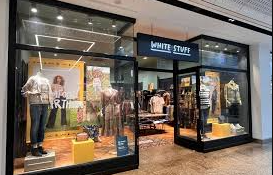Suppose you have ever left your flat beneath a cobalt-blue sky only to be drenched by lunchtime drizzle and shivering under a sudden hail burst come evening; congratulations. In that case, you have experienced classic London weather. The capital’s micro-climates famously squeeze a meteorological year into a single day, forcing locals to master the art of adaptive outfitting. Enter white stuff, the British label whose color-saturated, story-rich collections are designed to shape-shift with the city’s mood swings. But layering is more than piling garments at random; it is a considered choreography of fiber, fit, and function that keeps you dry on the South Bank, cozy on the Tube, and still stylish at the pub. This guide breaks down a practical philosophy—born in misty parks and open-top buses—that turns every White Stuff piece into a mobile micro-climate control system.
Decoding London’s Climate Curveballs
Meteorologists describe the city’s maritime temperate climate as “changeable”; seasoned commuters call it “utterly bonkers.” Warm Atlantic fronts can collide with Arctic highs, dropping temperatures ten degrees within an hour and switching sunshine to sheet rain faster than you can shout, “Mind the gap!” Successful layering, therefore, hinges on versatility: fabrics that breathe when the sun appears yet insulate against cold snaps, silhouettes that slip over one another without bulky discomfort, and palettes that work whether you are glowing in golden light or grey gloom. White stuff designers read the same forecast we endure and bake adaptability into their garments at the fiber-spinning stage—think brushed organic cotton that traps warmth without weight, viscose-linen blends that channel heat away from the skin, and reversible quilting that doubles the coat roster without doubling the wardrobe rail.
The Foundation Layer: Breathable Bases That Play It Cool
Every architectural marvel stands on solid foundations, and layering begins with the piece closest to the skin. White Stuff’s signature Breton tees, woven from Fairtrade cotton-modal jersey, regulate moisture better than pure cotton alone; the modal fibers’ tiny pores wick perspiration, averting that clammy sensation common on a packed Central Line carriage. If you favor dresses, slip a sleeveless bamboo jersey tank beneath—it remains invisible under cap sleeves yet provides a wicking barrier. For early-morning frost, lightweight merino shells in pastel hues deliver surprising thermal punch while remaining slim enough to tuck neatly into high-waisted corduroys without bunching. white stuff The cardinal rule: foundations must hug rather than strangle because comfort evaporates when seams chafe during a sprint across Waterloo Bridge.
Mid-Layer Magic: Knits, Corduroy, and Warmth Without Bulk
Mid-layers open the real styling theatre, providing both insulation and personality. White Stuff’s lambswool-viscose cardigans, knitted with moss-stitch texture, trap air in tiny pockets—nature’s central heating—yet drape softly enough to slide under a quilted shacket. Prefer a pullover? Opt for the brand’s color-blocked funnel-neck knit: the half-zip collar stands tall against wind tunnels along Tottenham Court Road but can be unfastened and flipped inside when the sun emerges over St. Paul’s dome. white stuff For trousers, wide-wale corduroy in jewel tones not only adds tactile interest but also generates micro-friction heat, a phenomenon older cyclists call “cord thermodynamics.” If your office air-conditioning oscillates between sauna and tundra, stash a cropped cotton-blend hoodie in your tote; the brushed inner face is soft enough for desk snuggling, and the cropped cut keeps proportions balanced when layered over longer shirts.
Outer Armor: Shielding Against Rain, Gusts, and Evening Chill
Now for the top shell—the line of defense that must handle London’s most theatrical weather flips. The hero piece in the white stuff arsenal is the reversible parka: one side is waxed cotton that beads rainfall like duck feathers, the other matte twill in earthy patterns that pair with weekend denim. Taped seams and concealed draw-cords shut out draughts without screaming “technical gear,” preserving café credibility. On milder days, try the brand’s cult quilted shacket—a jacket-shirt hybrid—or a water-resistant overshirt stitched from ripstop linen-nylon (linen for breathability, nylon for drizzle defiance). Hood preference divides locals; if you loathe the bulky silhouette, clip a detachable hood onto lapel buttons or carry a packable bucket hat that folds to passport size. white stuff The secret is modularity: pieces should snap, zip, or roll away so you can dial your micro-climate up or down throughout the day.
Accessory Alchemy: Scarves, Hats, and the Mighty Pocket
The smallest variables often decide layering wins. A White Stuff woven scarf—jacquard wool in winter, gauzy viscose in spring—wraps twice around the neck without strangling and slips into a coat pocket when the Thames Path suddenly feels Mediterranean. Fingerless gloves in recycled cashmere leave your phone-swiping digits free while adding a core-temperature bump disproportionate to their weight. Hats merit a paragraph of their own: wide-rib beanies in bold ochre or rust bring complexion-warming color to overcast selfies and stash easily inside your bag. Speaking of bags, London’s stop-start drizzle makes an external umbrella sleeve invaluable; White Stuff’s wax-canvas backpacks integrate one alongside a padded laptop sleeve, proving utilitarian need not look utilitarian.
The Commuter Capsule: Packing for Dawn-to-Dusk Versatility
Imagine a Tuesday agenda that reads: gym, client pitch, co-working brunch, gallery launch, late-night train home. A single day, five climates. Your White Stuff layering capsule could look like this: moisture-wicking stripe tee, lightweight Merino hoodie, cord pinafore dress (waist-tie converts it into an A-line skirt), quilted shacket, and a packable nylon skyline-print rain poncho. Footwear? Water-resistant leather Chelsea boots with cushioned insoles make the leap from workout commutes to the boardroom. Stash a silk neckerchief for unexpected chill—tie around ponytail if unused—and you have prepared for everything short of snowmageddon. The guiding mantra: every item must serve at least two scenarios and transition fast, ideally in the backseat of a taxi or the Café Nero restroom mirror.

Laundry and Storage: Keeping Layers Ready for Action
Care is half the battle in a layering wardrobe. Perspiration salts and London smog can degrade technical finishes, so embrace the 30 °C wash and eco-detergent pod. White Stuff’s care labels now include “refresh before wash” symbols; hang knits in a steamy bathroom or spritz with a lavender-vodka mist (an old theatre-costume hack) to kill odor-causing bacteria without a spin cycle. Dry flat to avoid shoulder bumps—those make layering lumpy—and store base layers rolled KonMari-style in drawers for quick visual inventory at 6 a.m. For outerwear, cedar-chip sachets deter moths, while breathable garment bags prevent dust without suffocating natural fibers. white stuff Keen to go circular? The brand’s SOJO partnership offers half-price repair vouchers with new knit purchases, ensuring a popped seam never benches your favorite mid-layer in a peak fog season.
Conclusion: Mastering Cinematic Layering with White Stuff
London’s skies may flip between film noir and technicolor without warning, but that makes the city an exhilarating style sandbox. Layering with white stuff is equal parts performance and practicality: experiment with unexpected color pairings, relish the tactile depth, and treat every doorway as a set change. When engineered fabrics meet story-rich prints, the result is clothing that keeps pace with unpredictable forecasts and urban adventures alike. So next time the weather app shows sun, cloud, and lightning all within three hours, smile—your wardrobe is already in rehearsal.
Frequently Asked Questions
1. How many layers are ideal for a typical London commute?
Three tend to suffice: a breathable base (cotton-modal tee or bamboo vest), an insulating mid-layer (lambswool cardigan or lightweight Merino pullover), and a weatherproof shell (reversible parka or quilted shacket). Accessories add micro-adjustments without bulk.
2. Does layering make me look bulky?
Not if you mind proportions. Choose fitted bases, slim mid-layers with strategic stretch, and outer shells with cinchable waists. White Stuff pieces often include hidden draw-cords, ensuring shape control even when fully layered.
3. What fabrics should I avoid in changeable weather?
Heavy, non-breathable synthetics—think low-grade polyester fleece—trap heat and moisture. Instead, pick fiber blends (e.g., cotton-modal, linen-nylon) that balance ventilation with weather resistance.
4. Can I layer dresses effectively?
Absolutely. Slip a bamboo or merino tank underneath, pull a cropped cardi on top, and add fleece-lined tights. When rain threatens, throw on a mid-thigh waxed cotton trench; the dress remains the hero garment all day.
5. How often should I wash layered knits?
Far less than you think. Wicking base layers needs frequent laundering, but mid-layer wool retains antibacterial lanolin, so airing is often enough. white stuff Wash only after five to seven years unless stained, using a gentle wool cycle to maintain loft and fit.
